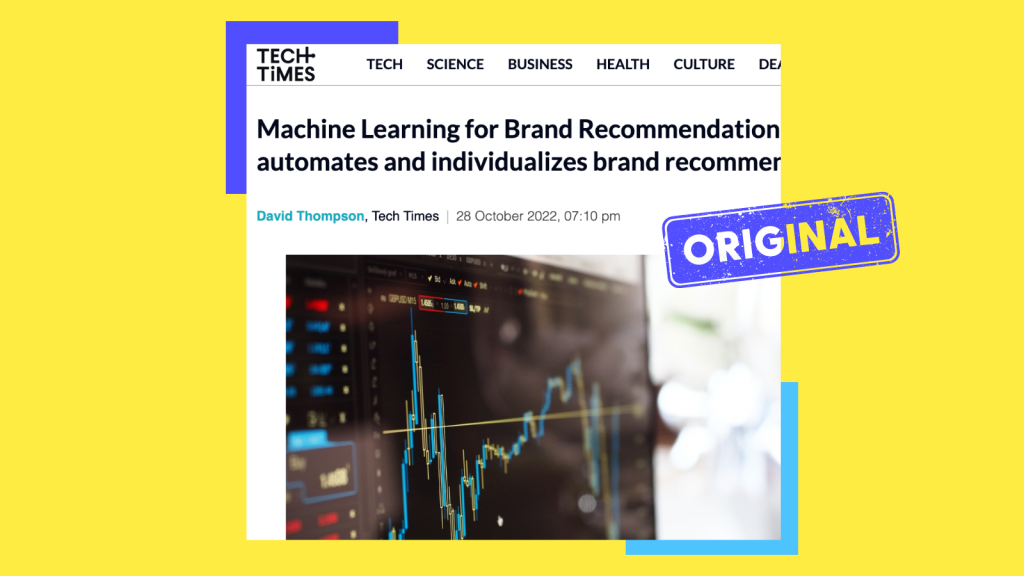ℹ️ The following is a re-print of the original Tech Times article, “Machine Learning for Brand Recommendation: How a Berlin start-up automates and individualizes brand recommendations”, written by David Thompson, originally seen here: https://www.techtimes.com/articles/282621/20221028/machine-learning-for-brand-recommendation-how-a-berlin-start-up-automates-and-individualizes-brand-recommendations.htm ℹ️

>>
In an online world where choice is so abundant, it can be a daunting task to narrow down a selection.
Just how overwhelming can it be? The Amazon Marketplace features over 350 million products for sale alone, according to an article from financesonline.com. YouTube creators have uploaded billions of videos over the years. And Forbes reported last year there are nearly 9 million mobile apps in existence.
Rapid advancements in technology have kicked open many doors for consumers and smaller, mid-size and larger brands, all trying to reach customers. But now the need to address choice overload has become a product of that growth.
Personal reviews from family and friends, and even product reviews written by consumers, only scratch the surface in combating the problem of choice. That technique only exposes the consumers to some products, already eliminating a plethora of other products out there that might better fit someone’s needs. And for brands that are trying to market products to converting customers, the practice of reviews alone just isn’t enough.
When tasked with narrowing down billions of choices on the web everyday dependent on a host of variables, it’s an impossible feat to accomplish by human hands. One of the most effective solutions, therefore, is introducing more technology into the mix by way of brand recommendation strategies.
Automated/individual brand recommendation technology
Kyle Smith, head of intelligence for Compado, a global start-up based in Berlin, Germany, said the technology company uses hard data, rankings and machine learning software to help funnel potential customers to brands.
“And we are helping the consumers by actually providing some kind of compass to them to navigate the sheer amount of choice they have,” Smith said.
Brand recommendation technology in its simplest terms is a method of data analysis that connects a user with a brand and a brand with valuable traffic. It helps narrow down choice with the use of certain parameters extracted from information that comes along with the user during a visit. That data is automated and individualized by collected information about the source in which a visitor arrived at the site, the time of day of the visit, the device being used, keywords searched and other information set up from the marketing channel.
“We are really tailoring it to the user level. Each user can have a huge set of individual parameters,” Smith said. “The more parameters we have, the more individualized this recommendation becomes. We draw recommendations on anything and everything we can get.”
Smith said once the data is collected, it is fed into Compado’s machine learning model that will then provide a valuable live predictions list of the most likely partners with which the user will be best matched.
“We are a market maker,” he said. “We have supply on one side and demand on the other side. We are trying to match that supply to that demand in each individual match as best we can.”
Machine learning that converts
In operation since 2017, Compado is about two years into the development of artificial intelligence through a comprehensive machine learning model.
According to the company’s lead of machine learning and ranking, Zlata Tanovic, the team responsible for Compado’s leading-edge machine learning department is comprised of data scientists who are responsible for developing the ranking models and business analysts who study the rankings and look for improvements in the system.
“Not everything is as perfect as possible from the beginning, so there is always room for improvement,” she said.
Compado’s machine learning tool is a statistical model that considers the data provided and then extracts from that data the information needed to be able to predict the rankings. Those predictions are made by comparing the data collected from the new user to historical data from other users who have demonstrated similar activities.
“This happens for every single person who visits the website based on the characteristics they have,” Tanovic said.
She said in order to build a foundation that will lend itself to effective predictions, the technology must first look at the population of previous visitors before it can determine rankings for individuals.
“That’s one of the reasons we had to come up with something original. When it comes to first-time visitors, we cannot really look at what this person did in the past. You have to start new every time someone comes,” she said. “We don’t have much information on a first-time user. It’s not like we can track this user on Google and see what they have been doing. For instance, the things we know come from our marketing channels and from what we learn about our users once they are on our properties, such as what they answer on a quiz.”
Using cloud-based technology to record a user’s actions to build the recommendations, Compado develops the pipelines where the machine learning models can be continuously trained to deploy for live predictions when users enter the site. The practice of constant training and retraining is crucial in achieving the best results, Tanovic said.
“We retrain the models on a daily basis,” she said. “We are always making sure that the entire pipeline is robust to any changes that might happen in the future. It is a statistical problem that doesn’t have a clear solution that you can reuse. You have to really come up with something that is not yet out there – and that’s what we’re doing.”
Additionally, Tanovic said it is imperative that she and her colleagues find different avenues to collect new information that will help strengthen recommendations resulting in more effective predictions, ultimately driving valuable traffic to partners.
“I think what we do well is keep a lot of flexibility in what we are doing. We are constantly iterating and adding more parameters to try out different versions,” Smith said. “We are trying to get the best technology out of that. That’s really key to what we at Compado are doing. The underlying technology is there for everyone, but we have created our own model to be able to rank brands better than anyone else. We are constantly tweaking to fit it to our business case and to connect brands with customers even better. It’s definitely different from the general use cases that you see.”
Staying competitive and paving the way
Both Smith and Tanovic agree the two most important components to a successful machine learning tool is a strong data infrastructure and the ability to learn from data in real time, which is an element that sets Compado apart from other recommendation services for subscriptions and apps.
Smith said one misconception in the industry is that anything that is automated is machine learning. He said there is a significant difference between a developer performing some number crunching and training a model to manage statistical and mathematical insight.
“Having machine learning set up is much more technically tricky,” he said. “It’s really about having that constant flow and integration and consistent optimization that really helps.”
Operating the software for recommendations between the brand and the user is just one form the technology can take. At the moment Compado uses the technology for ranking and quizzes, but it is a software developed to essentially decide what brand gets the presence. To that end, there is opportunity to scale the technology for additional uses, such as comparing brands or showcasing a specific brand.
“We are acquiring media and content sites regularly,” Smith said. “We can use our recommendation engine to scale those as well. That is in the near future. We aim to be first at the table and really make sure we can make media sites better by equipping them with our machine learning capabilities.”
Tanovic said Compado is spearheading brand recommendation technology through the company’s machine learning tool. Although the company has only been implementing the practice for a few years, the growth and accomplishment so far has been rewarding.
“To me, the sky’s the limit,” she said. “I am looking forward to seeing how my team can take automating and individualizing brand recommendations even further.”
<<


